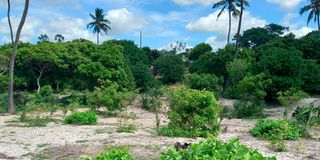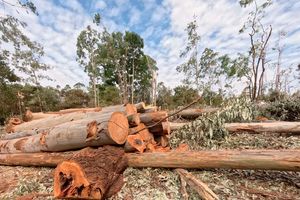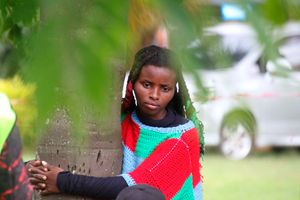
A section of a degraded Kaya forest in Matuga.
“Forests and Food” is this year’s theme for the International Day of Forests, celebrated on Friday this week.
It underscores the essential connection between forests, food and nutrition security.
More than five billion people around the world use forests and non-timber forest products for food, medicine and livelihoods, according to the Food and Agriculture Organisation (FAO). Kenya’s forests are the water towers of our nation.
They are the lifeline that nourishes our communities with sustenance, regulates our climate, and serves as vital water catchment areas.
Yet today, they face unprecedented threats that put not only their survival at risk, but also threaten the very foundations of our food, water and nutrition security.
When President William Ruto lifted Kenya’s logging moratorium in 2023, my heart sank for both our forests and the future of our country where two-thirds of our land is arid or desert.
While the promise of jobs seemed urgent, and the promise of controlled logging seemed familiar, we’ve seen this story before: rampant forest destruction by illegal loggers has been almost impossible to check in a fragile balance between livelihoods and ecological survival.
The moratorium was the result of a crisis in forest destruction: there was rampant illegal logging that left parts of water towers like Mt. Kenya, the Aberdares, and Mau devastated. Yet even as our courts later halted the reversal, the threat persists.
Once home to vast indigenous forests that nourished our land and people, we are now among the least forested nations in Africa, with only 8.8 per cent forest cover and 12 per cent tree cover — a far cry from the 10 per cent forest cover minimum required by our own Constitution.
Worse, 10 per cent of Kenya’s 1,100 native tree species are already threatened with extinction. Continuing to allow commercial plantations in indigenous forests would continue to put our water and food security at risk, clawing back gains that the country has made in the past years.
My mother, Professor Wangari Maathai, stood as a fierce guardian of Kenya’s forests, refusing to let commercial greed silence her vision for ecological justice.
When exotic plantations were carved into indigenous forests and logging ravaged them, she saw communities losing their lifelines, food insecurity growing, and rivers drying. Her resignation as assistant Environment minister in 2005 was a defiant act of integrity.
She was rejecting policies like the “shamba system” that were meant to balance farming and tree growth, but instead left soils barren and vulnerable to landslides, floods, and droughts.
Worse, it became a cloak for illegal logging, eroding trust in sustainable stewardship. Her memo explaining her exit was a call to reclaim forests as living, thriving systems, not commodities to be exploited.
But another, perhaps even more important issue deserves our focused attention on this World Forest Day - The Forests of the Sea (Kelp forests).
They are among the most productive and biodiverse marine ecosystems and yet remain severely under protected and underfunded.
The State of the World’s Kelp Forests, published in the scientific journal OneEarth, showed that only 16 per cent of the kelp biome is in some form of protected area, with only 2 per cent in a highly protected and effective area.
Furthermore, a meagre 20,000 hectares of kelp forests have been restored, 2 percent of the global restoration target.
This despite the fact that Kelp forests cover more than one-third of the world’s coastlines, offer ecosystem services exceeding $500 billion globally, occur within 50km of at least 740 million people.
They support coastal livelihoods and cultural values, sequester at least 31 million tons of CO₂ annually, contributing to climate-change mitigation, and form the foundation of complex marine food webs, supporting thousands of species from invertebrates to whales.
I spent the past week immersed in the Great African Sea Forest witnessing filmmakers Craig Foster and Swati Thiyagarajan at work in this underwater wonderland.
After getting used to the freezing cold waters off the Cape Coast, I marvelled at how marine life’s resilience, complexity and vulnerability mirrors our own. “There is no green without blue,” a mantra famously created by renowned marine biologist Dr. Sylvia Earle aka, “The Queen of the Deep” resonated profoundly within me.
Here where these amazing kelp forests cradle an entire universe of life, I realised my own appreciation and reverence for forests has always been incomplete.
This is because, despite the role of Kelp Forests as coastal guardians of the planet, and inspirations for Oscar-winning stories like Craig and Swati’s My Octopus Teacher they have remained the invisible giants of conservation.
Our collective silence on their plight is a call for us to rewrite the narrative of a planet where land and sea are one.
On this World Forest Day where Forests and Food unite us, may we finally see the blue as the backbone of the green. Happy International Day of Forests…All forests!
Wanjira Mathai is the MD for Africa & Global Partnerships at the World Resources Institute and Chair of the Wangari Maathai Foundation.












